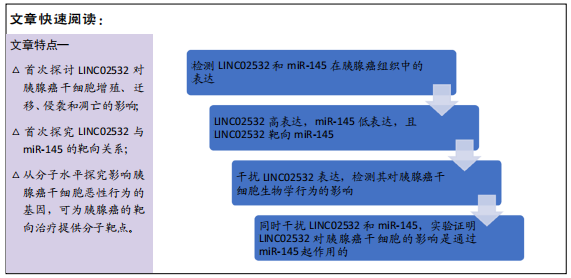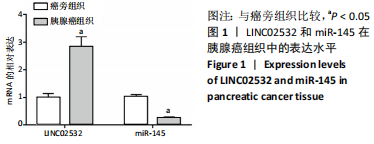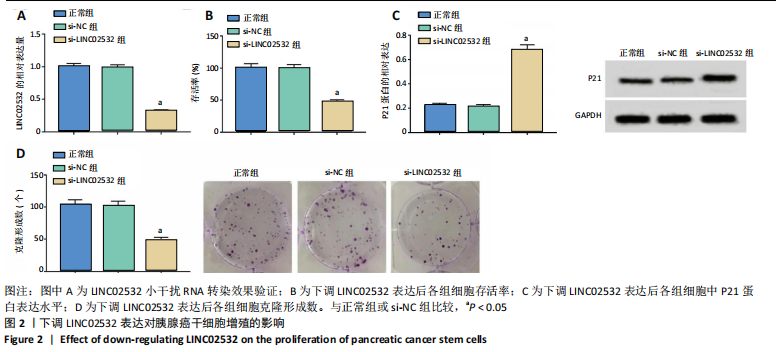中国组织工程研究 ›› 2022, Vol. 26 ›› Issue (1): 52-58.doi: 10.12307/2022.009
• 肿瘤干细胞 cancer stem cells • 上一篇 下一篇
LINC02532靶向miR-145影响胰腺癌干细胞的增殖、迁移、侵袭和凋亡
孟德峰,李长仔,吴春涛
- 华北理工大学附属医院肿瘤外科,河北省唐山市 063000
Effects of LINC02532 targeting miR-145 on proliferation, migration, invasion and apoptosis of pancreatic cancer stem cells
Meng Defeng, Li Changzai, Wu Chuntao
- Department of Oncology Surgery, North China University of Science and Technology Affiliated Hospital, Tangshan 063000, Hebei Province, China
摘要:

文题释义:
长链非编码RNA(lncRNA):长度超过200个核苷酸的小分子非编码RNA,参与调控细胞的增殖、分化和凋亡等生命活动,与肿瘤的发生发展密切相关,是肿瘤治疗的潜在分子靶点。微小RNA(miRNA):长度为18-25个核苷酸的小分子非编码RNA,可与其靶基因的3'非翻译区靶向结合,调控其靶基因的表达,进而影响细胞增殖、迁移和侵袭等生命活动。研究还表明,lncRNA可作为竞争性内源性RNA与miRNA靶向结合,进而调控其靶基因的表达。
背景:长链非编码RNA(lncRNA)和微小RNA(miRNA)是两类参与调控细胞增殖、凋亡和迁移等生命活动的小分子非编码RNA,且lncRNA还可作为竞争性内源性RNA与miRNA靶向结合,调控miRNA靶基因的表达,在肿瘤的发生发展中起重要作用。LINC02532可靶向结合miR-129-5p和miR-490-5p促进胃癌细胞增殖、迁移和侵袭,但对胰腺癌干细胞生物学行为的影响及作用机制还未知。
目的:探讨LINC02532对胰腺癌干细胞增殖、迁移、侵袭和凋亡的影响及作用机制。
方法:①选取2017年1月至2018年6月于华北理工大学附属医院经病理检测证实为胰腺癌且经手术切除的56例患者胰腺癌组织及癌旁组织,实时荧光定量PCR(RT-qPCR)检测LINC02532和miR-145的表达水平;②以CD24+CD44+ESA+为表面标记,流式细胞术在人胰腺癌细胞PANC-1中分选胰腺癌干细胞,分为正常组、si-LINC02532组(转染LINC02532小干扰RNA)、si-NC组(转染乱序无意义阴性序列)、
si-LINC02532+anti-miR-145组(共转染LINC02532小干扰RNA和miR-145抑制剂)和si-LINC02532+anti-miR-NC组(共转染LINC02532小干扰RNA和miR-145抑制剂阴性对照序列)。转染12 h后,RT-qPCR检测各组细胞中LINC02532和miR-145表达水平,CCK-8法检测细胞存活率,克隆形成实验检测细胞克隆形成数,Transwell小室检测细胞迁移和侵袭能力,流式细胞术检测细胞凋亡率,Western blot法检测细胞中P21、Bax、Caspases-3、E-钙黏附素和基质金属蛋白酶2蛋白表达水平。双荧光素酶报告基因实验验证miR-145与LINC02532调控关系。
结果与结论:①与癌旁组织比较,胰腺癌组织中LINC02532表达水平升高(P < 0.05),miR-145表达水平降低(P < 0.05);②与si-NC组比较,si-LINC02532组胰腺癌干细胞存活率、克隆形成数、细胞迁移和侵袭数及基质金属蛋白酶2蛋白表达水平降低(P < 0.05),细胞凋亡率及P21、Bax、Caspase-3和E-钙黏附素蛋白表达水平升高(P < 0.05),而si-NC组与正常组各检测指标比较差异无显著性意义(P > 0.05);③LINC02532在胰腺癌干细胞中靶向负调控miR-145表达。与si-LINC02532+anti-miR-NC组比较,si-LINC02532+anti-miR-145组胰腺癌干细胞存活率、克隆形成数、细胞迁移和侵袭数及基质金属蛋白酶2蛋白表达水平升高(P < 0.05),细胞凋亡率及P21、Bax、Caspase-3和E-钙黏附素蛋白表达水平降低(P < 0.05);④结果表明,LINC02532在胰腺癌组织中表达上调,下调其表达可能通过靶向上调miR-145表达进而抑制胰腺癌干细胞增殖、迁移和侵袭,并诱导细胞凋亡。
https://orcid.org/0000-0003-4434-9637(孟德峰)
中国组织工程研究杂志出版内容重点:干细胞;骨髓干细胞;造血干细胞;脂肪干细胞;肿瘤干细胞;胚胎干细胞;脐带脐血干细胞;干细胞诱导;干细胞分化;组织工程
中图分类号:







